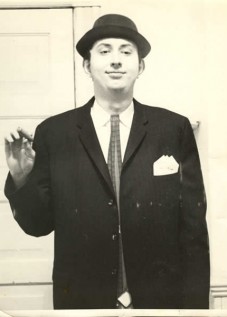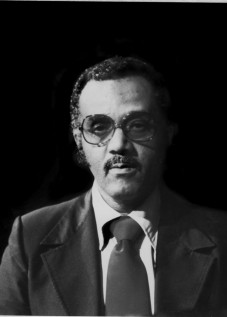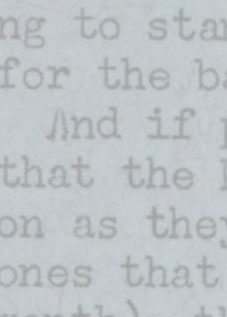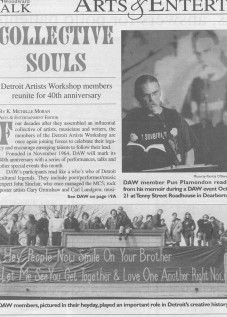James Semark
18 April 1940 – 28 November 2010
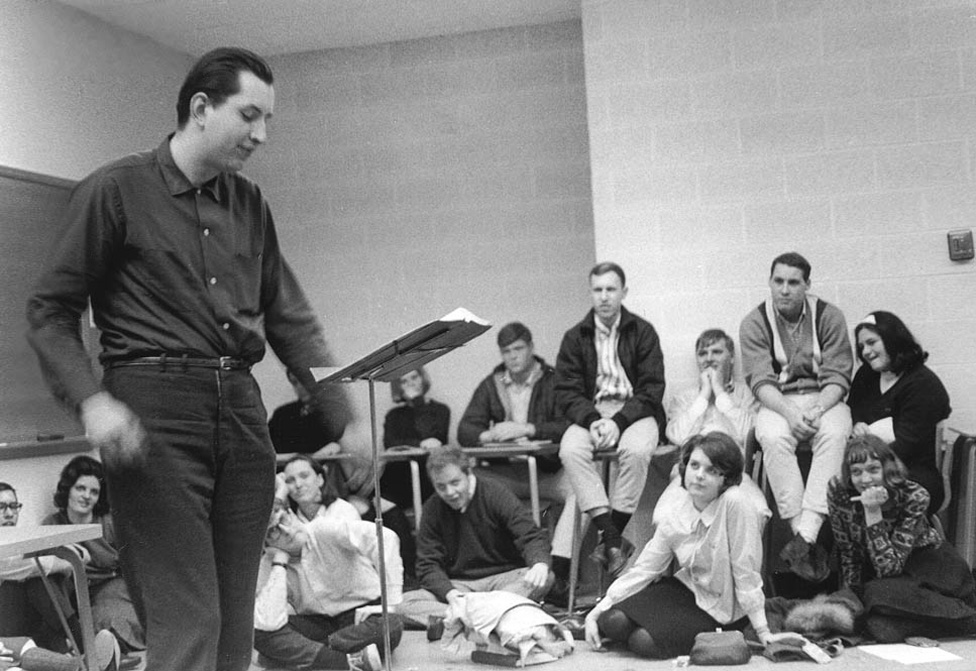
James Semark, 1965 – Photo by Leni Sinclair
Poet, musician, futurist, co-founder Detroit Artists Workshop
On one hand, we experience the collapse of an economy built by people who put self-interest first, and on the other, we discover an economy of consciousness shaped by people who put the planet first – and themselves in it. -James Semark
James Semark departed this earthly plane sometime during the first week of December, 2010, his death due to a possible heart attack or possible complications from an allergic reaction to antibiotics, something we will never know as an autopsy was never done. The coroner’s office explained it as “death by natural causes.” He was found alone at home with the front door left unlocked, perhaps to not trouble anyone by having to break it down. His body was discovered by the Ferndale police several days after he died.
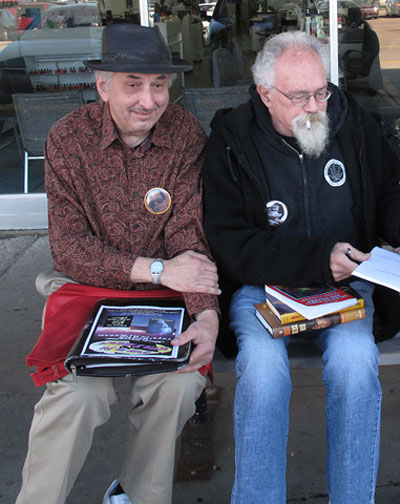
James Semark and John Sinclair at the Book Beat, Detroit 2009
James Semark was a poet, musician/composer, cosmic communicator, organizer and creative spirit born in Toledo, Ohio who moved to Detroit as a student at Wayne State University in 1959. His interests were diverse; from meditation and macrobiotics to technology, green-economics, jazz, urban renewal and theosophy.
James pioneered a type of early proto-rap form that he called the rhythm ballads. These late 50s and early 60s compositions were “investigative verse” works; long tripped-out epic poems set to music that undertook the study and description of jazz legends John Coltrane, Charlie Parker and even a judgment day “jazz-poem in heaven” of Edmund Zwingy, an imaginary be-bop star. He began to put the ballads to syncopated sound beats around 1964, inspired by jazz drummer Danny Spencer practicing in a basement room next to his own, in the John Lodge Artist Workshop “Castle”.
James studied music at Wayne State University and under his mentor Harold McKinney. McKinney’s idea of community and the “World Stage” was a major influence for Semark and the AWS. Semark was also mentored by jazz greats Yusef Lateef, Elvin Jones and Eric Dolphy. In the mid-1960s, Semark collaborated with Lyman Woodard, The DC5, MC5, Charles Moore and John Sinclair.
James was a tall, quiet, even-tempered and soft spoken person, but could suddenly and spontaneously ignite an audience with his blazing rhythmic oration and fiery live performances. James was equally influenced by occult writings and world religions as he was by beat poets and jazz artists. He often took on cosmic topics, questions about space, time and the universe, the origins of mankind, drugs and illusion. He was a founding member of the Workshop and his poetry found an audience through publications by the DAW press.
In his book Night-Vision Express, Semark wrote a series of surreal Kafkaesque essays. Many reflected on the afterlife. “The Antivalue” is one continuous rant that ends:
Guardians of the river Lethe, with their tortured honor and malafied smiles, transport Antivalue to the Tower of Xmea and throw him into the ocean… but it is transformed into the gnarled bones of circumvented lovers. From “Blood Echoes for Allen Ginsberg” – you and i we’re lucky / to know about expanded consciousness/ to get this far and not sentenced to “involuntary lobotomy”/ we’re lucky in this free / democratic republic/ rally-round-the-flag-boys/ society of ours/ to get by without any kind of “brain job”…
Semark’s poetry is infused with a kind of dystopian rock ‘n roll fever, a Burroughsian “Naked Lunch” stew, finding its home beside quotations from The Tibetan Book of the Dead, Kafka, Zen Buddhism, Sun Ra, Concrete Poetry, Stanley Mouse, Gary Grimshaw and Madame Blavatsky.
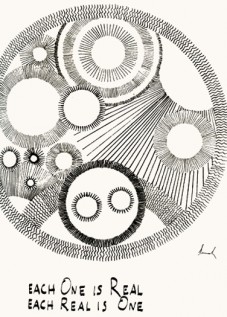 Semark was a holy goof saint, an architect for the coming psychedelic revolution. He mixed metaphors with dreams, plays, essays and made direct statements, rants and pleas to change mankind. His creativity and process was centered on consciousness and community. Forms were broken and arranged to fit his vision of expanded awareness. He was Detroit’s answer to Wavy-gravy and Allan Watts. He could be over-the-top, extreme and repetitive, reciting, “OH! EYE! OH EYE! YOU!” for pages and it wasn’t always easy to digest, his mania could were you down, but his enthusiasm, humor and eternal conversation with the cosmos and prehistoric monsters were fascinating to watch, and something to be discussed over the next millennium.
Semark was a holy goof saint, an architect for the coming psychedelic revolution. He mixed metaphors with dreams, plays, essays and made direct statements, rants and pleas to change mankind. His creativity and process was centered on consciousness and community. Forms were broken and arranged to fit his vision of expanded awareness. He was Detroit’s answer to Wavy-gravy and Allan Watts. He could be over-the-top, extreme and repetitive, reciting, “OH! EYE! OH EYE! YOU!” for pages and it wasn’t always easy to digest, his mania could were you down, but his enthusiasm, humor and eternal conversation with the cosmos and prehistoric monsters were fascinating to watch, and something to be discussed over the next millennium.
After one of the breakups of the Workshop in 1966, James struck out on his own, opening his Nova Express inspired “Terminal City” commune in Highland Park. He was “new age” before the term existed. The first to recognize and bring the distinguished founder of macrobiotics and the organic/natural foods movement Michio Kushi to Detroit. Semark did spread the word on organic living, publishing the first book by Kushi in English translation. He remained a strict vegan his entire life, convinced of the power of healing through pure foods and meditation.
James maintained a strong interest in metaphysics throughout his life. From his lifelong friendships with Robert Thibodeau and Howard Weingarden, to his weekly meetings (for over twenty years) with his metaphysical/theosophy study group, he had an inquisitive and questioning mind. Ever hopeful and on the side of intelligent transformation, James was an inspiration and light for many who sought positive change.
He was an early adapt of the Baha’i faith, embracing the idea of oneness in all religions and continued to explore ideas found within the writings of Theosophy and Madame Blavatsky. In the early 1970s, James was initiated into the Mahariji Ji Charon Singh‘s order, and continued daily meditation and ‘sound mediation’ practices throughout his life. Some of these rituals and practices are known as Radha Soami Satsang Beas or the Science of the Soul.
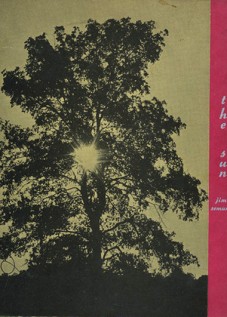 Semark’s third book The Sun (1966), is an exceptional and beautiful object/poem broken into two parts. In the first half are quotations from the Bahai faith, Sufi and Chinese poets, Sun Ra, Michio Kushi, Alice Bailey and Madame Blavatsky, all together forming a thick multi-cultural stew of spiritual truth. This radiant (and surreal) broth became the foundation for the Sun poem which stretches across the second half of the book. It is one of the most beautiful and powerful statements in poetry and art made by Semark. Punctuated by drawings, collages, letterpress embossing, colored and metallic inks and photos, the Sun poem is a cosmic rhythm ballad, a lovely handmade artbook that evolves through many forms and shapes; “When You and I are real, the words have Light.” At the end of the book, Semark states that he mixed the book’s special colored inks by his own hand. It remains one of the most powerful, well designed and spiritual books in the Workshop canon.
Semark’s third book The Sun (1966), is an exceptional and beautiful object/poem broken into two parts. In the first half are quotations from the Bahai faith, Sufi and Chinese poets, Sun Ra, Michio Kushi, Alice Bailey and Madame Blavatsky, all together forming a thick multi-cultural stew of spiritual truth. This radiant (and surreal) broth became the foundation for the Sun poem which stretches across the second half of the book. It is one of the most beautiful and powerful statements in poetry and art made by Semark. Punctuated by drawings, collages, letterpress embossing, colored and metallic inks and photos, the Sun poem is a cosmic rhythm ballad, a lovely handmade artbook that evolves through many forms and shapes; “When You and I are real, the words have Light.” At the end of the book, Semark states that he mixed the book’s special colored inks by his own hand. It remains one of the most powerful, well designed and spiritual books in the Workshop canon.
Another aspect of Semark’s character was his disciplined ongoing devotion to the Detroit Artists Workshop. Its community goals and ideals were his own and he maintained these throughout his life, even as he resided outside the state. His return to Detroit coincided with the planning stages for the 40th anniversary reunion in November of 2004. At that time, James took on an enormous responsibility in the preparation and development of the reunion project which led to a continuation of the DAW co-op in the form of meetings, concerts, fund-raising and its online presence as the website for The Detroit Artists Workshop, The DAW website was Semark’s baby and he designed and watched over it as a dotting parent.
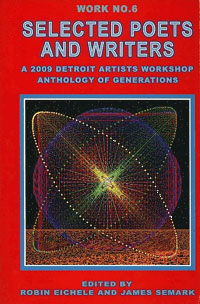 One of Semark’s last projects was Work #6: A 2009 Detroit Artists Workshop Anthology of Generations -an extension of the sixties era workshop, returning to familiar names and writers (Robin Eichle, Bill Harris, Ed Sanders, John Sinclair) and including many new and unheard of writers. He was, “building the reincarnated DAW collective as a vital platform, confident in its future as a world cultural hub.”
One of Semark’s last projects was Work #6: A 2009 Detroit Artists Workshop Anthology of Generations -an extension of the sixties era workshop, returning to familiar names and writers (Robin Eichle, Bill Harris, Ed Sanders, John Sinclair) and including many new and unheard of writers. He was, “building the reincarnated DAW collective as a vital platform, confident in its future as a world cultural hub.”
His epic environmental poem-ballad The Saga of Steely R. Stone (included in Work #6), was an autobiographical self-portrait, a sketch of a man loosing his beautiful wife Jenny due to a toxic poisoning, so he envisions a horrid apocalyptic landscape on the planet, finally causing a nationwide uprising that resounds in the collective chant, “WE’RE GONNA DO SOMETHING FOR OUR WORLD!” The poem was directed toward his lovely wife Judith Janis, a strong supporter of peace, multiculturalism, Trans-Love Energies, and traditional Indian dance – a peaceful and grounded counterpart for James. Judith died of cancer suddenly in 2007 – and that was heartbreaking.
The Workshop website Semark worked on, designed and helped create, was over several hundred pages long. The website, his writings and his deep archive of DAW publications and records were sadly lost soon after his death. A quick auction of his belongings dispersed a major portion of the Workshop writings and artworks. One lost element was a thick scrapbook, actually a Valentine from Gary Grimshaw to Judith when they lived together in late 60s. It was filled with Grimshaw memorabilia, small hand drawings, postcards and flyers – one of the treasures of the DAW.
Semark had a visionary approach to language and an unshakeable belief in the Workshop – he saw it as a model and beacon through which future generations could learn and establish their own networks of artistic sharing and growth. It would seem an injustice to Semark and others involved with the DAW to see that legacy disappear. The objects may be gone but a light remains.
In 1964, the Workshop was a spiritual foundation for artistic freedom. It was infused with a bohemian ideology similar to the Beat generation and the Black Arts Movement, and it contained the roots of psychedelia and Punk. It was the key moment of the Detroit counter-culture, whose ideas exploded in the later half of the 1960s and as one of the founders, poets and an elder statesman of that movement and energy, James Semark was a mighty force, a cyclone we barely knew.
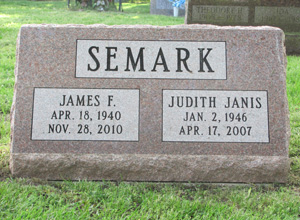
The grave of James and Judith, Clinton, Lenawee County, MI
In a quotation from his own website chronology, James states:
“However long I may live, the endgame will still hold true. You’ll notice that, in my 20s, I was a hot shot in the Artists Workshop and I thought I had it together. In my 30s and 40s, I thought I understood the cosmos. In my 50s I had a vision of world transformation. Now, in my later years, I realize I understand only a milli-fraction of what’s going on in the universe — it’s as though I don’t understand anything at all! On the other hand, I see no end to the discovery process — the opportunity to explore greater and greater realms of galactic mind goes on forever. This is the endgame.”
Cary Loren, December 2 2010, Detroit
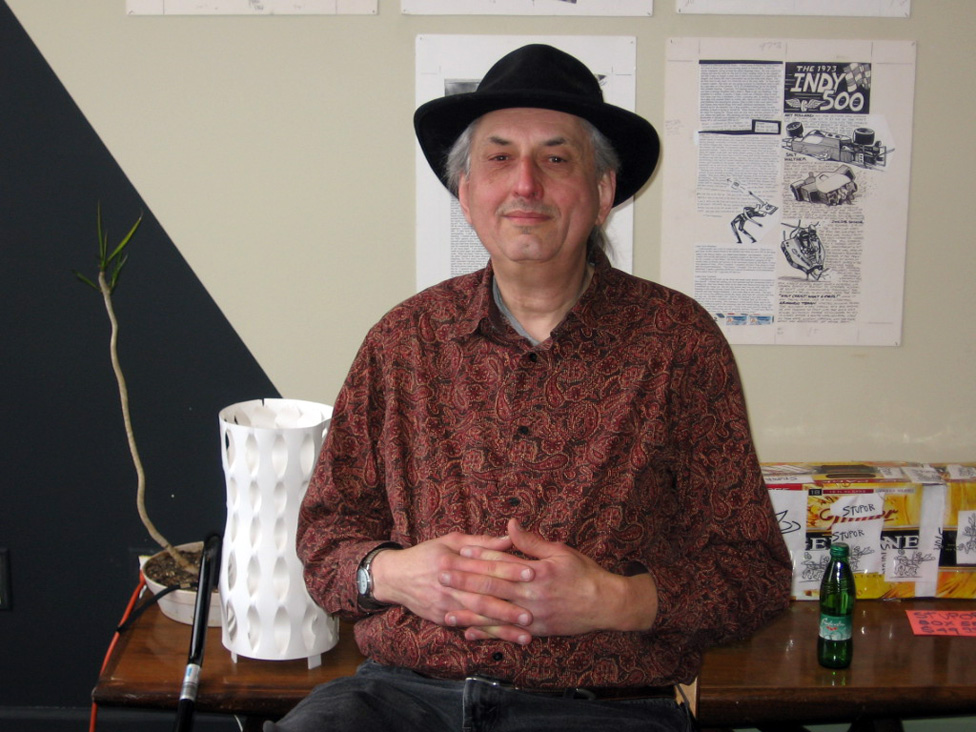
James Semark, 2010 – © Monika Berenyi
Tags: James Semark



